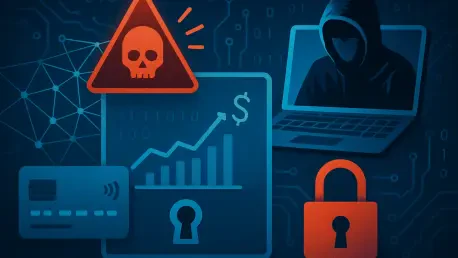In an era where digital transactions underpin the global economy, the security of fintech platforms has never been more critical, and a recent breach at Checkout.com, a leading payment processor, has sent shockwaves through the industry. This incident, orchestrated by the infamous cybercrime group ShinyHunters, exposed vulnerabilities in outdated infrastructure, raising urgent questions about the safety of sensitive data in an increasingly interconnected world. The breach not only compromised internal records but also highlighted a glaring oversight in the management of legacy systems, serving as a stark reminder of the risks that lurk in neglected corners of digital architecture. As cybercriminals grow more sophisticated, this event underscores the pressing need for robust cybersecurity measures and proactive system maintenance. The fallout from this breach offers valuable lessons for companies across the fintech sector, prompting a deeper examination of how such an incident occurred and what steps are being taken to prevent future lapses.
Uncovering the Vulnerability in Legacy Infrastructure
The breach at Checkout.com was a direct result of an outdated cloud storage system, abandoned years ago yet never fully decommissioned, creating a perfect entry point for ShinyHunters to exploit. This legacy system, no longer in active use for core operations, still housed sensitive internal records and merchant onboarding data, making it a goldmine for cybercriminals seeking to extract valuable information. The failure to properly retire this infrastructure allowed attackers to access data that potentially impacts a significant portion of the company’s merchant base, estimated at around 25%. While the active payment processing environment remained secure, with no compromise of payment card details or live transaction data, the exposure of historical records poses risks of reputational damage and potential misuse of information. This incident reveals a critical oversight in digital asset management, where even dormant systems can become liabilities if not addressed with rigorous security protocols, emphasizing the hidden dangers of outdated technology in modern enterprises.
Further investigation into the breach reveals that the legacy system’s vulnerability stemmed from a lack of continuous monitoring and updates, which left it defenseless against evolving cyber threats. ShinyHunters, known for targeting weak points in corporate networks, likely exploited outdated security configurations or unpatched flaws to gain unauthorized access. The fact that such a system remained connected to the broader network, even in a dormant state, highlights a systemic issue in how companies handle end-of-life technology. For fintech firms like Checkout.com, where trust and data security are paramount, this lapse serves as a cautionary tale about the importance of comprehensive decommissioning processes. Beyond simply shutting down old systems, there must be a thorough audit to ensure no residual data or access points remain exposed to potential threats. This breach illustrates how even a single neglected component can jeopardize an entire organization’s security posture, urging a reevaluation of infrastructure management practices across the industry.
The Response Strategy and Ethical Standpoint
In the aftermath of the breach, Checkout.com’s response was swift and resolute, beginning with a refusal to bow to ShinyHunters’ ransom demands, a decision that set a strong precedent against cyber extortion. Instead of capitulating, the company launched an exhaustive security investigation to assess the extent of the damage and identify affected data. This principled stance was further reinforced by a commitment to donate an equivalent sum to cybersecurity research at renowned institutions, aiming to bolster systemic defenses against future attacks. By taking this approach, Checkout.com not only avoided incentivizing cybercriminals but also contributed to broader industry efforts to combat digital threats. This response reflects a growing trend among organizations to prioritize long-term security over short-term resolutions, signaling a shift in how breaches are managed with an eye toward ethical responsibility and communal benefit.
Transparency played a central role in Checkout.com’s handling of the crisis, as the company’s Chief Technology Officer publicly acknowledged the oversight in failing to decommission the legacy system. This admission, coupled with active communication to notify potentially affected merchants, demonstrated a commitment to maintaining trust with stakeholders. The company also established dedicated support channels to assist merchants, offering guidance and resources to mitigate any fallout from the exposed data. Collaboration with law enforcement and regulatory bodies further underscored a proactive effort to address the breach comprehensively. Such openness is crucial in the fintech sector, where customer confidence hinges on reliability and accountability. By owning up to the mistake and taking tangible steps to support those impacted, Checkout.com aimed to rebuild trust while setting an example for how companies can navigate the delicate balance of crisis management and stakeholder relations in the wake of a cyber incident.
Lessons Learned and Future Safeguards
Reflecting on the breach, it became evident that the incident was a wake-up call for the fintech industry, exposing the perils of neglecting legacy systems in an era of relentless cyber threats. The failure to decommission outdated infrastructure at Checkout.com served as a painful reminder that every component of a digital ecosystem, no matter how obsolete, must be secured or properly retired. This event highlighted the need for stringent policies around system lifecycle management, ensuring that dormant assets are not left as backdoors for attackers like ShinyHunters. Industry-wide, there is now a renewed focus on auditing existing infrastructure to identify and eliminate similar vulnerabilities before they can be exploited. The breach emphasized that cybersecurity is not a one-time effort but an ongoing process requiring vigilance, resources, and a forward-thinking approach to protect sensitive data from increasingly sophisticated adversaries.
Looking back, the response to this breach also paved the way for actionable strategies that other companies could adopt in similar situations. Checkout.com’s decision to invest in cybersecurity research rather than pay the ransom marked a significant step toward systemic improvement, encouraging collaborative efforts to enhance digital defenses. The transparency shown in addressing affected parties and the commitment to strengthening security protocols offered a blueprint for maintaining trust post-incident. Moving forward, it’s clear that fintech firms must prioritize comprehensive decommissioning practices and continuous monitoring of all systems, active or not. This incident ultimately served as a catalyst for broader discussions on infrastructure security, urging organizations to allocate resources toward preventive measures and adopt a zero-tolerance policy for overlooked risks, ensuring that past oversights do not dictate future vulnerabilities.









